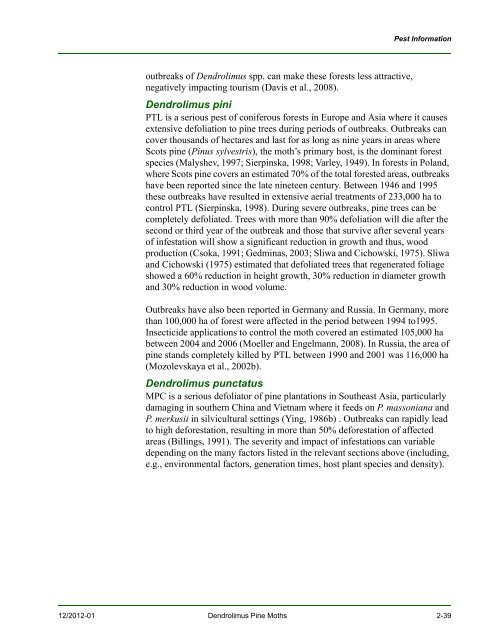New Pest Response Guidelines - aphis - US Department of Agriculture
New Pest Response Guidelines - aphis - US Department of Agriculture
New Pest Response Guidelines - aphis - US Department of Agriculture
You also want an ePaper? Increase the reach of your titles
YUMPU automatically turns print PDFs into web optimized ePapers that Google loves.
outbreaks <strong>of</strong> Dendrolimus spp. can make these forests less attractive,<br />
negatively impacting tourism (Davis et al., 2008).<br />
<strong>Pest</strong> Information<br />
Dendrolimus pini<br />
PTL is a serious pest <strong>of</strong> coniferous forests in Europe and Asia where it causes<br />
extensive defoliation to pine trees during periods <strong>of</strong> outbreaks. Outbreaks can<br />
cover thousands <strong>of</strong> hectares and last for as long as nine years in areas where<br />
Scots pine (Pinus sylvestris), the moth’s primary host, is the dominant forest<br />
species (Malyshev, 1997; Sierpinska, 1998; Varley, 1949). In forests in Poland,<br />
where Scots pine covers an estimated 70% <strong>of</strong> the total forested areas, outbreaks<br />
have been reported since the late nineteen century. Between 1946 and 1995<br />
these outbreaks have resulted in extensive aerial treatments <strong>of</strong> 233,000 ha to<br />
control PTL (Sierpinska, 1998). During severe outbreaks, pine trees can be<br />
completely defoliated. Trees with more than 90% defoliation will die after the<br />
second or third year <strong>of</strong> the outbreak and those that survive after several years<br />
<strong>of</strong> infestation will show a significant reduction in growth and thus, wood<br />
production (Csoka, 1991; Gedminas, 2003; Sliwa and Cichowski, 1975). Sliwa<br />
and Cichowski (1975) estimated that defoliated trees that regenerated foliage<br />
showed a 60% reduction in height growth, 30% reduction in diameter growth<br />
and 30% reduction in wood volume.<br />
Outbreaks have also been reported in Germany and Russia. In Germany, more<br />
than 100,000 ha <strong>of</strong> forest were affected in the period between 1994 to1995.<br />
Insecticide applications to control the moth covered an estimated 105,000 ha<br />
between 2004 and 2006 (Moeller and Engelmann, 2008). In Russia, the area <strong>of</strong><br />
pine stands completely killed by PTL between 1990 and 2001 was 116,000 ha<br />
(Mozolevskaya et al., 2002b).<br />
Dendrolimus punctatus<br />
MPC is a serious defoliator <strong>of</strong> pine plantations in Southeast Asia, particularly<br />
damaging in southern China and Vietnam where it feeds on P. massoniana and<br />
P. merkusii in silvicultural settings (Ying, 1986b) . Outbreaks can rapidly lead<br />
to high deforestation, resulting in more than 50% deforestation <strong>of</strong> affected<br />
areas (Billings, 1991). The severity and impact <strong>of</strong> infestations can variable<br />
depending on the many factors listed in the relevant sections above (including,<br />
e.g., environmental factors, generation times, host plant species and density).<br />
12/2012-01 Dendrolimus Pine Moths 2-39

















